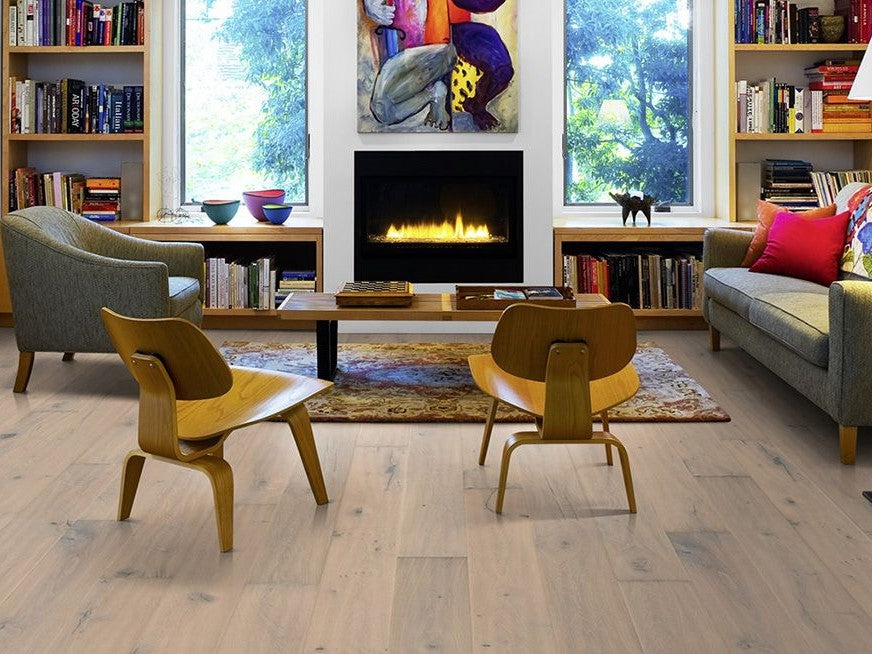Your Cart is Empty
 Solid hardwood flooring is the original wood floor type. It’s easy not to underestimate how much of an effect your choice of flooring has on your home, but beautiful floors are the very foundation of a welcoming interior. Taking time to ensure you make the right choice is essential. With a rise in the number of flooring types from which to select, it might seem a little overwhelming. We’ve created this informational guide to show you why solid hardwood is still the number one floor type, what other hardwood floors are available and how hardwood flooring can transform your interiors. Read on to find out how solid hardwood floors can enhance the look of your home.
Solid hardwood flooring is the original wood floor type. It’s easy not to underestimate how much of an effect your choice of flooring has on your home, but beautiful floors are the very foundation of a welcoming interior. Taking time to ensure you make the right choice is essential. With a rise in the number of flooring types from which to select, it might seem a little overwhelming. We’ve created this informational guide to show you why solid hardwood is still the number one floor type, what other hardwood floors are available and how hardwood flooring can transform your interiors. Read on to find out how solid hardwood floors can enhance the look of your home.

The revolutionary alternative to laminate flooring, vinyl plank floors are a modern and affordable choice for both home and commercial spaces. These are durable, versatile floors that can easily be installed by a novice homeowner. Incredibly popular, vinyl flooring is impervious to water, making it suitable for kitchens and bathrooms, having been known to survive flooding. The floorboards are also finished with a slip-resistant coating, making vinyl ideal for family homes with lively youngsters or pets. Vinyl flooring is available in a variety of colours and wood types. As with all floor types, luxury vinyl comes with its drawbacks. While this flooring type is hard-wearing, it is prone to scuffs from sharp objects or high heels, which may cause irreversible damage. Vinyl flooring can become discoloured from continuous exposure to direct sunlight, losing its attractive lustre, which impossible to refinish. Further, glue down vinyl flooring is notorious for its difficulty to remove, having stuck down firmly to the subfloor. This flooring type may also be a cause for concern for the environmentally conscious, as it is currently not biodegradable. SEE IF VINYL IS YOUR OPTION
A less costly substitute for solid hardwood flooring, engineered wood floors are crafted from multiple wooden layers (likely of plywood) with a solid hardwood veneer placed on top. Extremely durable and long-lasting, these cost-effective floors can be placed anywhere in your home, including in basements. The high quality veneer gives this floor type a convincing authenticity, and the layered construction provides more stability than hardwood, as changing humidity levels will not cause unwanted movement. This makes engineered wood a good choice for basements and rooms with underfloor heating. The biggest difference between engineered wood and solid hardwood is the lifespan. Unlike solid hardwood flooring, which still fill the floors of century-old country houses, engineered wood will never last as long; this floor type can only be sanded and refinished a handful of times, depending on the thickness of the wood. Style options are more limited than vinyl or laminate as engineered wood flooring contains a solid wood upperlayer, not a photographic wood-effect coating. This layer of real wood also increases the price, making engineered wood one of the more expensive floor types. BROWSE THROUGH ENGINEERED WOOD FLOORING RANGE
While solid hardwood is generally considered to be an excellent choice, there are some occasions where another floor type would better suit your circumstances. Moisture-heavy environments like bathrooms and basements are a bad idea as solid hardwood expands and contracts depending on the levels of moisture in the air, causing damage to the wood itself. Kitchens, however, are a more unusual choice, though all spills will need to be mopped up almost immediately. Solid hardwood in children’s bedrooms and playrooms can cause accidents but a warm, fluffy, slip-resistant rug should prevent these missteps. Otherwise, these floors work pretty much perfectly everywhere else.
If you’re looking to update your floors and give your home a makeover, solid hardwood flooring is a firm favourite with many households. Great for opening up a space, adding resale value and protecting against allergens, solid wood floors are built to last with timeless charm. With countless colours, styles and finishes, browse our catalogue to find that perfect floor.


